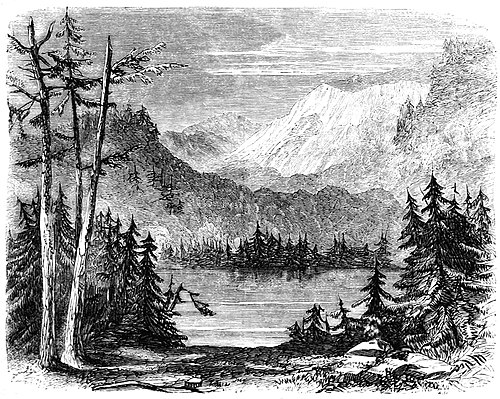Once a Week (magazine)/Series 1/Volume 2/St. Anne's Lake, Transylvania
ST. ANNE’S LAKE, TRANSYLVANIA.

Beyond the Baths of Tasnad there is a chain of mountains extending towards the east as far as Kézdivásarhely,[1] rising ridge above ridge, covered by ancient forests; not a village or a hamlet is to be found in this solitary region; and even the high road through the country avoids its lonely wilds, tracked only by the paths of the hunter—even these are less beaten than centuries ago, when many a castle, now a ruin, in the midst of the forest, was inhabited by its hospitable lords, and the woods rang with the sounds of the bugle and the voices of hunter-trains.
In the midst of this vast and profound solitude, undisturbed by the storms which sweep the mountain, lies a sheet of still water, associated from the earliest ages with religious memories, which, like the valley of the Ganges to the Hindoo, the temple of the golden visions to the Hellenic poet, or the shades of Igdrasil to the Scandinavian, consecrates to the Transylvanian the “Lake of St. Anne.” The bosom of this mountain basin lies 3000 feet above the level of the sea, an elevation little below the summit of Snowdon or Ben-Lomond; but here a deep valley surrounded by hills, which rise 1200 feet higher, covered with a cloud of oak and beech, while gigantic pines spread a deep and solemn shadow round the pale waters of the Lake, tinged with a silvery green by the reflection of the wooded hills. The absence of every human sound, and the deep silence which sleeps upon the valley, gives an imposing sense of awful repose, the mysterious influence of which is heightened by the magical effect of a wonderful echo, which, as it spreads round the Lake, rises by degrees until it dies away in a prolonged cadence, almost an octave higher than its original tone.
According to tradition, when the rites of the ancient Huns were confined to their solitudes and fastnesses, it was at the Lake of St. Anne that they made sacrifice to the god of war; and afterwards, when the light of the true faith had banished these dark superstitions, a chapel dedicated to the Mother of our Lady, was founded on the ashes of the pagan fires by one of the earliest Christian ladies, to whom St. Anna had appeared in a dream. This solitary fane became a place of great devotion, until the sacred walls having been profaned by a false vow, were struck by lightning and reduced to a ruin. Subsequently, however, they were restored by one of the bishops, and the valley became again animated by the Szekler pilgrims: its lonely water brightened with the reflection of their gonfannons, and its echo prolonging the cadence of their hymns. Beside the chapel, there was also a small dwelling with a bell-turret, the habitation of the “Pilgrim Father.” But now all have disappeared; the storms of war have reduced the chapel to a heap of ruins; the echoes are silent; and no living shadow is reflected in the still water, but the deer which comes down to drink at its margin, and the heron which watches in its pools.
- ↑ In the south-east, near the confines of Moldavia.